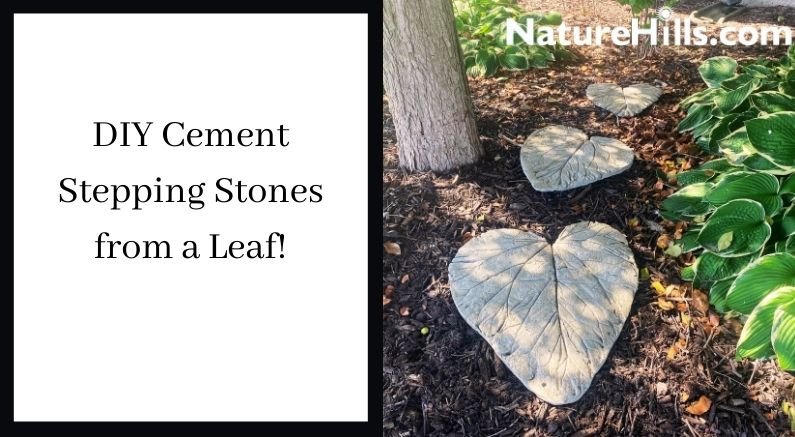Preserving the beauty of the natural world and making a lasting keepsake from your own garden is easier than you think! Create magical outdoor decor that preserves nature’s beauty for years!
You’ve probably seen them made from Elephant Ears, Rhubarb leaf, and even Hosta, really any leaf that is the size you are looking to use, works great for your cement leaf stepping stones. Experiment with different leaf shapes and sizes, or use pre-shaped plastic stepping stone molds, or even old cake pans!
In this project, large Rhubarb leaves were used and Portland Cement, but any Type I or Type II cement that is fine-grained enough to pick up the impression of the leaf.
Tools needed:
- Cement
- 3-5 Gallon Bucket
- Flat trowel (or spatula)
- Water
- Rags for clean up
- Plastic sheets
- Gloves, mask, apron, and old clothing/shoes
- Cooking Spray or oil
- Optional Chicken Wire or Mesh for extra support
- Fresh Leaves
- Wire brush or power-washer
- Sandpaper
- Cement sealer or outdoor paint
Step by Step:

1. Lay plastic on your work surface to protect the area. It’s a good idea to have a rag ready for wiping spills before they dry.
2. Wear gloves, old clothing or an apron, and a mask since concrete/cement can have a lot of dust that you do not want to breathe.
3. Prepare the cement per instructions on the package, creating a thicker consistency that won’t run, yet thin enough to spread easily.
4. Prepare the leaf by spraying lightly with cooking oil. Preferably, the underside that features protruding veins. This will make removal easier later on. A 2-gallon bucket, half full of cement created one medium-sized leaf.
5. Working quickly, the cement begins to set fast depending on the type you’ve chosen. Working from the center, use the trowel to spread outwards, adding more cement as you go.
6. At this point, place your reinforcement mesh or chicken wire, then top with another layer of concrete mix.

7. Keep adding and gently spreading the concrete onto the leaf, gently pressing outwards towards the edges, ultimately accumulating about ½-1 inch thick. Be sure to keep it level and smooth.
8. Use the trowel to flatten the sides so they’re thick enough to not break when stepped on.
9. Lightly spray with water if the cement is setting up too quickly, allowing you to smooth out air bubbles or bumps, and smooth the edges.
10. Clean up! Wash everything before the cement sets.
Let set undisturbed in the sun for at least a day. Again, depending on the type of cement you are using, possibly less.
12. Once set and dry, flip the stepping stone once it is set, and expose the leaf to the sun and let it dry out before peeling. Remove what you can with the wire brush to whisk away the foliage and get into all the grooves. Or use your power washer to gently blast away the leaf bits.

13. Use sandpaper to smooth the edges of the leaf if there are any sharp edges.
14. Once thoroughly dry, apply a Sealant, or paint it if you wish with outdoor paint first!

In just an hour of your time, you’ll have a lasting keepsake to grace your garden! DIY projects are a fantastic way to decorate and preserve nature’s beauty!
Highlight your DIY concrete stepping stones even by heading over to NatureHills.com and pick up some Creeping Thyme or other groundcovers to plant between your stones and some edging plants like Dianthus! You’ll have a polished pathway where plain ground once lay.

